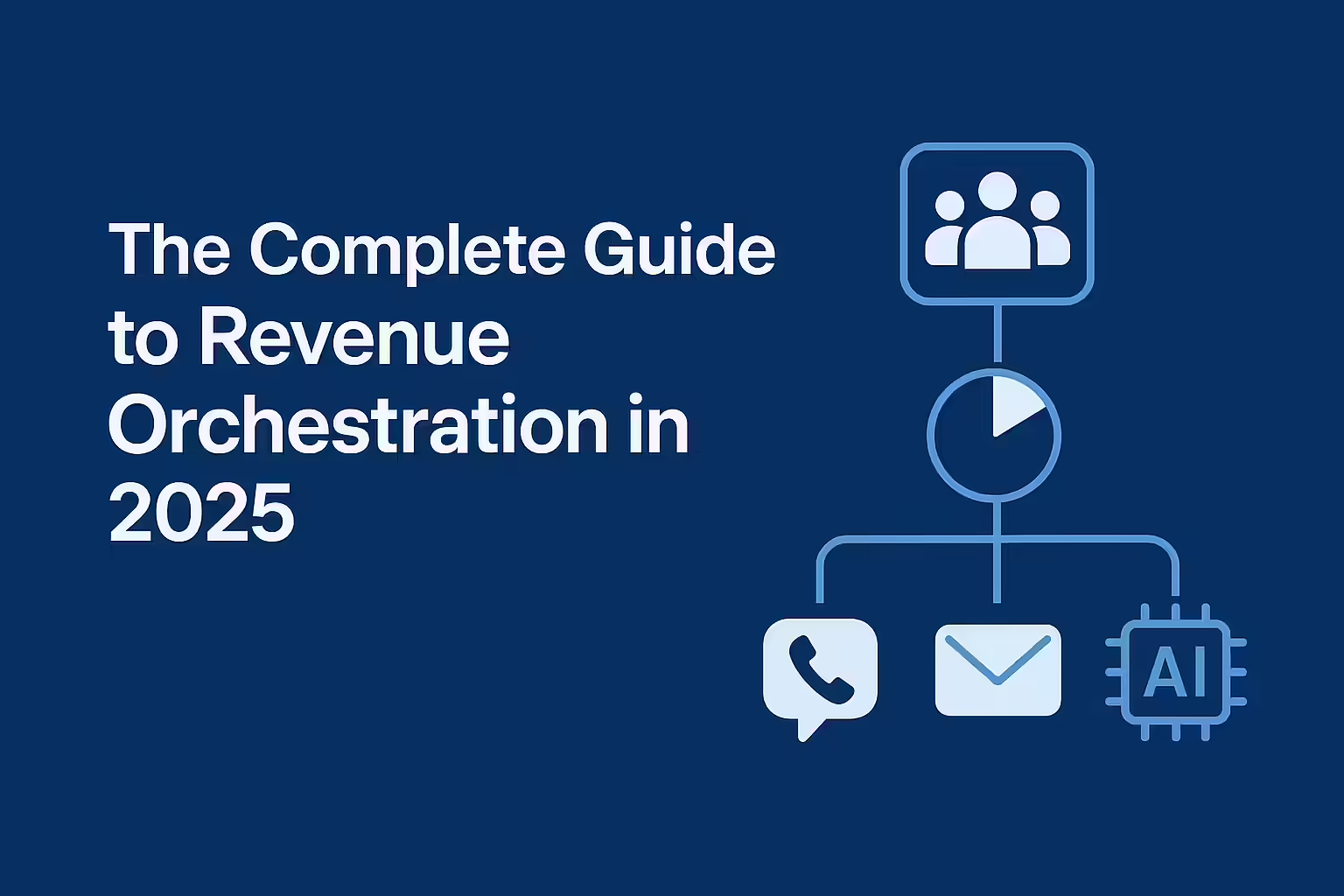TL;DR
| Why It Matters | What’s New in 2025 | How Kixie Helps | Action Items |
|---|---|---|---|
| Buyers expect instant, tailored outreach across voice, SMS, and AI‑driven cadences. | ROPs unify data, insights, and execution in real time, powered by Gen‑AI and tighter CRM‑CDP alignment. | Kixie’s PoPower DialerSMS automations, AI Coaching, and webhook‑first integrations snap into any modern ROP stack. | Audit your RevOps tech, map the Kixie dialer + automation layer, and pilot three high‑impact plays (below). |
What Is Revenue Orchestration—and Why the Buzz in 2025?
Your go-to-market teams are likely feeling the strain. Sellers are juggling 10+ tools per deal, spending more time on admin than on selling, and working from fragmented data that leads to disconnected customer experiences. This is the operational friction that Revenue Orchestration is built to eliminate.
Revenue Orchestration is the discipline of coordinating data, channels, and workflows so every buyer interaction is timely, contextual, and value‑driven. Think of it as RevOps 2.0: where traditional automation ends, orchestration begins. It shifts the paradigm from siloed tools to a unified system of action.
| Legacy Automation | Modern Orchestration |
|---|---|
| Point‑tools trigger siloed tasks (e.g., a single email drip). | Connected systems decide when, how, and why to engage—across voice, SMS, email, ads, and AI chat. |
| Static playbooks updated quarterly. | Real‑time adjustments from predictive models and feedback loops. |
| CRM ≈ system of record. | CRM + CDP + ROP ≈ system of action. |
2025 Catalysts Driving the Shift Towards Revenue Orchestration
- AI Everywhere – Gen‑AI, and now emerging Agentic AI, not only surfaces next‑best actions and writes contextual snippets but is starting to execute complex workflows autonomously.
- Signal Density – First‑party intent (calls, SMS, web visits, product usage) now crowds out less reliable 3rd‑party data, demanding a system that can capture and act on it instantly.
- Compliance Tightening – New TCPA rules elevate the need for precise, automated opt‑in logic and audit trails across all communication channels.
- Platform Convergence – The market itself is validating this trend. With major mergers like Clari acquiring Groove and Salesloft acquiring Drift, the industry is consolidating around platforms that bridge data, decisioning, and delivery.
The 2025 Revenue Orchestration Platform Stack
A modern ROP isn’t a single product but a strategy supported by four key technological pillars.
| Pillar | Purpose | Example Tools |
|---|---|---|
| Data Unification | Clean, deduplicated, real‑time 1P data. | Segment, RudderStack, HubSpot Operations Hub |
| Predictive Intelligence | Scoring, propensity, send‑time optimization. | Salesforce Einstein, HubSpot AI, custom LLMs |
| Execution Layer | Multi‑channel delivery with adaptive logic. | Kixie Dialer + SMS, Outreach, HubSpot Workflows |
| Feedback Loop | Closed‑loop analytics & coaching. | Power BI, Looker, Kixie AI Coaching |
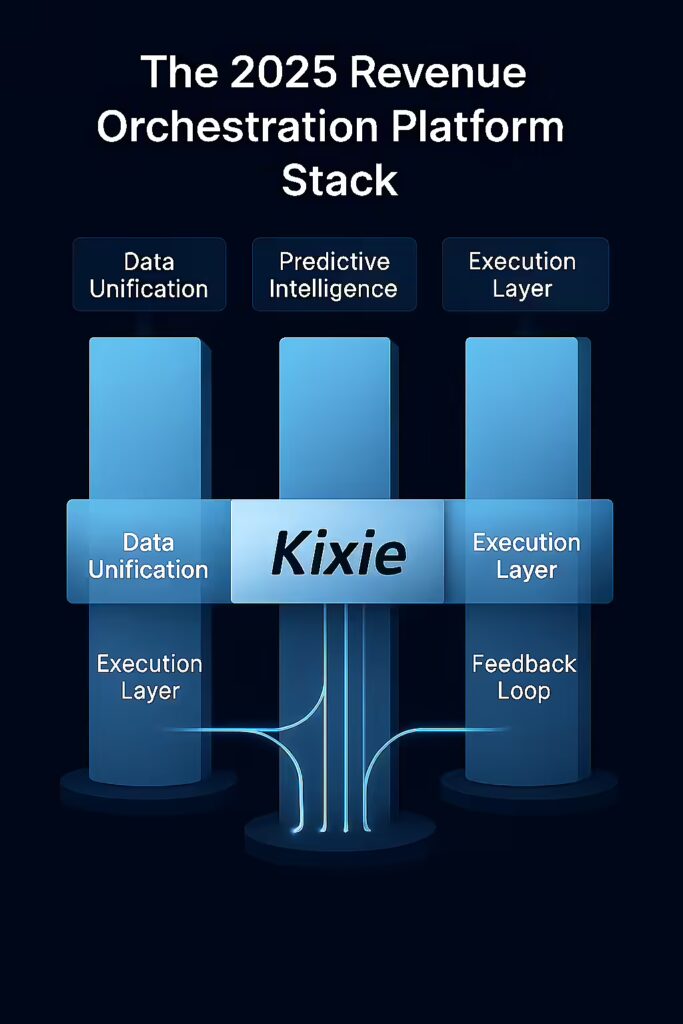
Unpacking these pillars reveals their interdependence. A staggering 78% of enterprises report that AI adoption stalls because they don’t trust their underlying revenue data. Without a solid Data Unification layer, your Predictive Intelligence is working with flawed inputs. Likewise, your Execution Layer is only as smart as the intelligence feeding it. Sophisticated tools can now even provide real-time conversation intelligence, flagging sarcasm via tonal analysis to feed richer data back into the system. And finally, the Feedback Loop closes the circuit, enabling both analytics and micro-level collaboration through features like Kixie’s Team SMS shared inboxes for real-time team-based problem-solving.
Kixie squarely sits in the Execution + Feedback layers—all while piping granular call/SMS events back to your data unification layer.
Where Kixie Fits: Dialer‑First Orchestration Superpowers
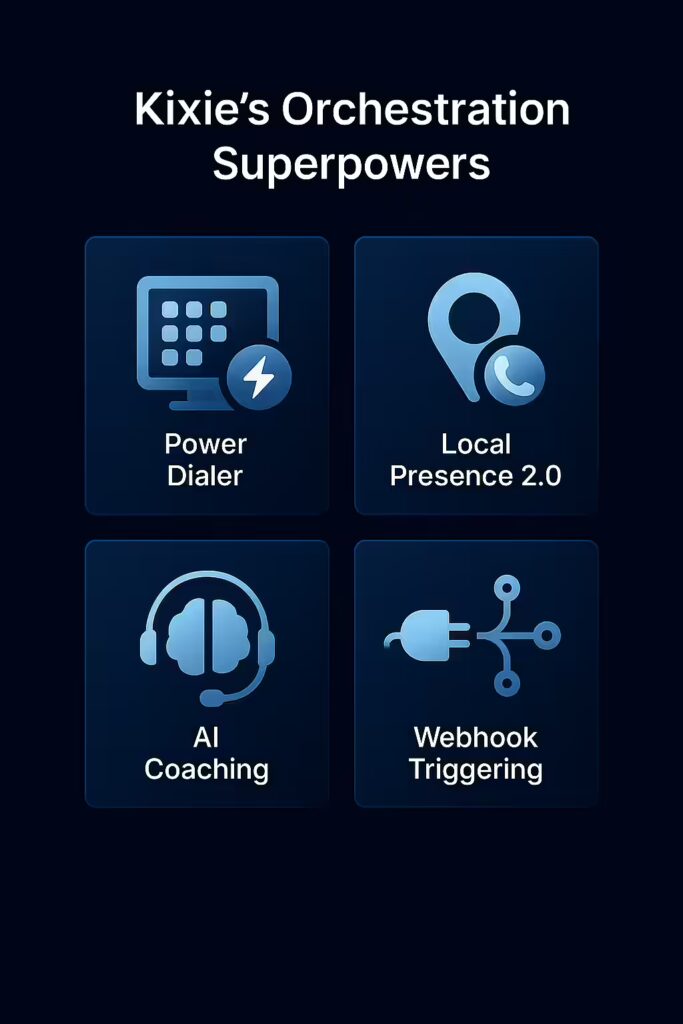
Instant, Contextual Conversations
- Parallel & Power Dialing: Call 10× faster, with systems that auto‑pause on connect and log dispositions, notes, and outcomes to HubSpot/Salesforce in real time.
- Dynamic Caller ID (Local Presence 2.0): Automatically match a prospect’s area code to boost answer rates—now engineered to be fully TCPA‑compliant.
- Conversational AI Coaching: Receive post‑call summaries, competitive and objection-based tagging, and rep‑specific feedback within minutes of a call ending.
Trigger‑Based Automations
Kixie’s webhook-first architecture and deep CRM integrations allow for powerful, automated plays that define modern orchestration.
- Inbound “Hot Lead” Play
- Trigger: A web form is submitted on your website, captured in a CRM like Pipedrive.
- Orchestration: Kixie auto‑calls the lead within 30 seconds. If there’s no answer, it sends a personalized SMS and then schedules the contact into a power‑dialer session for the assigned rep later that day.
- Lifecycle Nurture Escalation
- Trigger: A contact’s lifecycle stage in HubSpot stagnates for more than 14 days.
- Orchestration: Automatically kick off a Kixie voicemail drop + multi-day SMS drip. Sync conversation replies to an enablement platform like Seismic for deeper insights.
- Renewal Risk Rescue
- Trigger: A customer’s health or adoption score dips below a threshold in Gainsight.
- Orchestration: The assigned CSM gets an urgent task and the customer is added to a Kixie priority call queue, complete with real‑time sentiment cues from past interactions.
Webhook‑First Flexibility
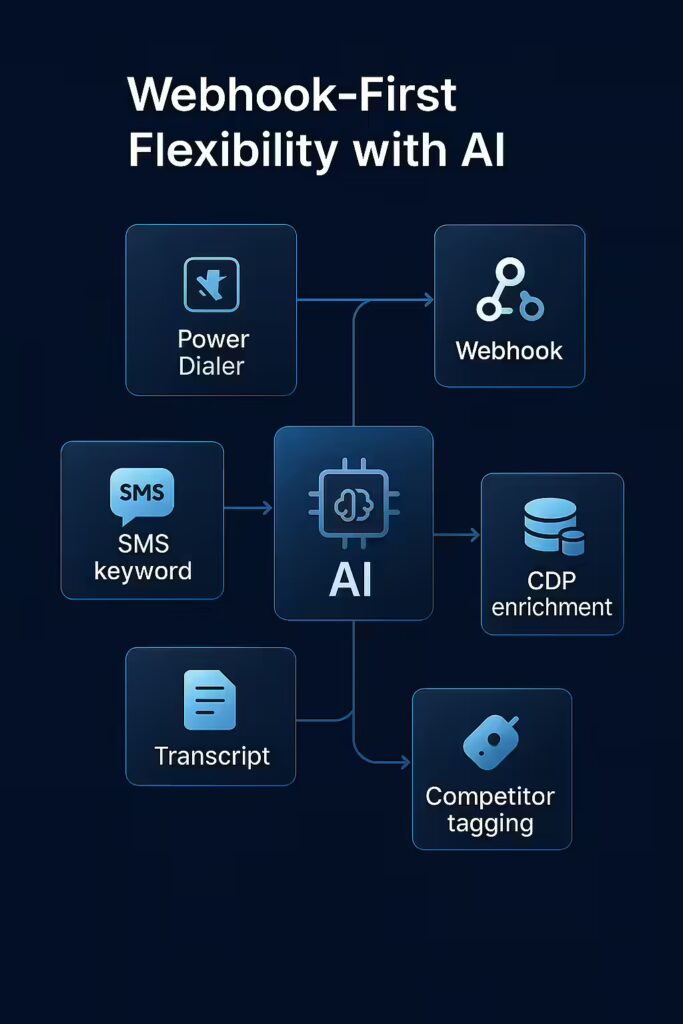
Every Kixie call, SMS, and disposition change emits a real-time webhook. This makes it a perfect trigger for low-code platforms like n8n or Make.com, or for your own in-house AI agents. Combine that with AI to:
- Update opportunity health scores in your CRM mid‑conversation based on keyword triggers.
- Push transcribed pain points directly into your CDP for next‑best‑action modeling.
- Enrich CRM contact records with detected competitors for smarter win‑loss analysis.
Proof of ROI: The Tangible Impact of Orchestration
Theory is good, but results are better. Adopting a revenue orchestration strategy powered by a smart execution layer like Kixie delivers quantifiable business impact.
- Massive ROI and Win-Rate Lift: A 2025 Forrester Total Economic Impact (TEI) study found that companies using this model achieved a 3.3× ROI, saw a 12% lift in close-won rates, and realized $1.3 million in tool-consolidation savings.
- Explosive Pipeline Generation: Using 6sense for intent signals and Kixie for automated execution, PTC generated $18 million in new pipeline in just four months.
- Drastic Efficiency Gains: Fischer Homes tripled their outbound call volume and contact rates by implementing dialer automation, allowing a small team to perform like one three times its size.
Building Your End‑to‑End Revenue Orchestration Playbook
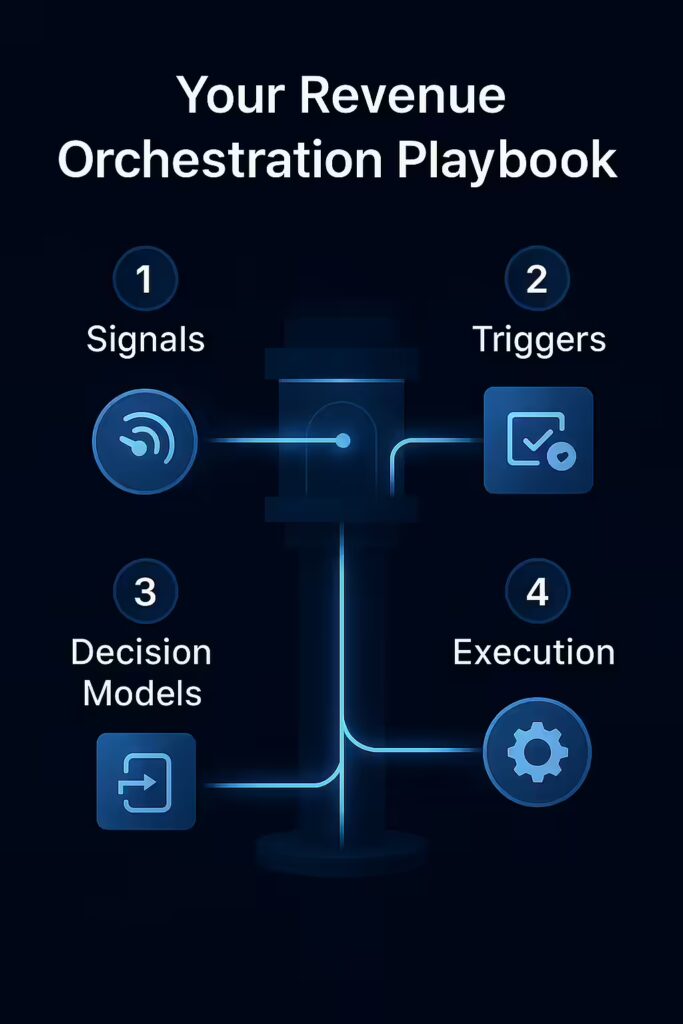
| Step | Objective | Kixie Tactics |
|---|---|---|
| 1. Map Signals & Systems | List every buyer touchpoint and identify every data silo. | Turn on Kixie’s native call and SMS logging to unify all engagement data inside your CRM. |
| 2. Define Revenue Moments | Identify high‑impact triggers (e.g., MQL → SQL, demo held, churn risk). | Configure Kixie automated call and SMS sequences that are tied directly to each moment. |
| 3. Layer Decision Models | Apply scoring, send‑time AI, or custom LLM‑based routing rules. | Feed Kixie call outcomes and dispositions back to your AI model; use propensity scores to adjust the dialer queue order dynamically. |
| 4. Execute & Iterate | Launch your plays, monitor the conversion lift, and relentlessly refine. | Use Kixie’s real‑time dashboards and Power BI views to A/B test your cadence variants and double down on what works. |
Measuring Success: 2025 ROP KPIs
Your metrics must evolve along with your strategy. Move beyond vanity metrics to track true orchestration efficiency.
- Speed‑to‑Connect (S2C): Median time from an intent signal trigger to the first live conversation.
- Conversational Coverage: Percentage of target accounts with ≥ 2 live calls and 1 SMS reply within a given cycle.
- AI‑Assisted Conversion Lift: The win‑rate uplift on deals touched by AI‑guided dialer queues vs. a control group.
- Rep Coaching Score Delta: Month‑over‑month improvement in rep performance based on Kixie’s AI Coaching scores.
- Revenue per Rep Hour: The ultimate output metric—revenue generated per logged dialing hour, benchmarked by team and segment.
The Change Management Blueprint: How to Roll Out Your ROP
Switching to an orchestrated model is a strategic shift, not just a software install. A phased approach ensures buy-in and success.
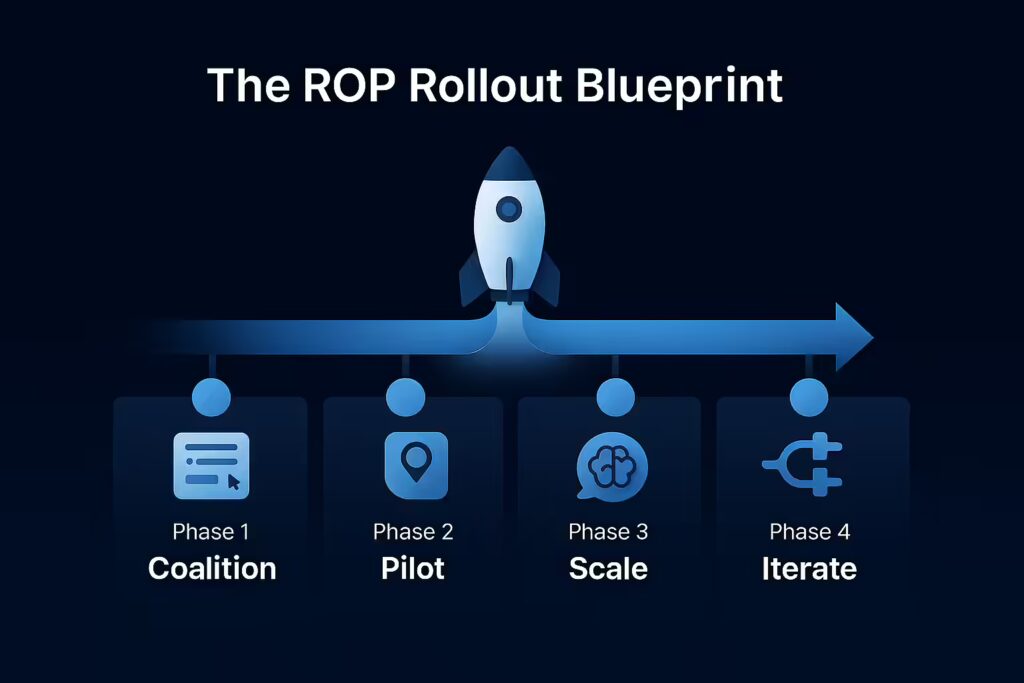
- Phase 1: Build a Coalition & Define the Pilot
- Gather leaders from Sales, Marketing, and Operations. Agree on the most critical problem to solve first (e.g., inbound lead response time).
- Deploy Kixie with a small, motivated group like your top-performing SDR team. Focus on one high-impact play.
- Phase 2: Launch the Pilot & Measure Everything
- Execute the defined play for 30-60 days. Integrate Kixie’s webhook events into a tool like n8n or HubSpot Workflows.
- Track the core KPIs (especially Speed-to-Connect and meetings booked) and gather qualitative feedback from the team.
- Phase 3: Scale & Standardize
- Use the pilot’s success metrics to build a business case for a wider rollout.
- Standardize the best-performing plays and expand Kixie’s use to adjacent teams, like Account Executives or Customer Success.
- Phase 4: Iterate & Optimize
- An orchestration engine is never “done.” Continuously feed performance data from BI dashboards back into the system to refine predictive models, adjust playbooks, and identify new automation opportunities.
Compliance in an AI‑Dialer Era
As you increase outreach velocity, you must also scale compliance.
- TCPA 2025 Updates: Kixie’s built‑in consent management and automated throttling help keep you within legal call and SMS frequency limits.
- Data Residency & SOC 2: Ensure all your voice and SMS data is stored on‑shore with robust encryption at rest and in transit.
- Granular Audit Logs: Every call, SMS, and automation event is time‑stamped and exportable for documentation and legal review.
Conclusion & Next Steps
Revenue orchestration isn’t just another buzzword—it’s the operational backbone of every high‑growth GTM strategy in 2025 and beyond. By embedding Kixie’s intelligent dialer and automation engine into your ROP stack, you gain the critical execution and feedback layers needed for:
- Faster, smarter buyer conversations at scale
- Unified engagement data for predictive AI models
- Embedded compliance and scalable rep coaching
Ready to orchestrate every revenue moment?
Frequently Asked Questions (FAQs)
1. What exactly is “Revenue Orchestration”?
Revenue Orchestration is a workflow‑centric strategy that unifies data, channels, and AI‑powered insights so Sales, Marketing, and Customer Success operate from a single playbook—turning every buyer signal into the next best action. Analysts label the enabling software “Revenue Orchestration Platforms” (ROPs).
2. How is it different from traditional sales automation?
Automation fires off isolated tasks (e.g., send an email). Orchestration coordinates who, when, and how across voice, SMS, email, ads, and success motions—continuously tuned by AI and shared data. Think RevOps 2.0 versus “set‑and‑forget” sequences.
3. Where does Kixie fit into an ROP stack?
Kixie is the execution + feedback layer for real‑time conversations. Its popower dialerSMS automations, and webhook exhaust plug into any modern ROP or CRM, logging every call/text automatically and feeding rich intent data back to your analytics and AI.
4. What measurable ROI can I expect?
A 2025 Forrester Total Economic Impact™ study on a leading ROP reported 3.3× ROI, 12 % higher close‑won rates, and $1.3 M in tool‑consolidation savings over three years. Similar Kixie users have tripled outbound call volume or cut no‑shows by 50 %.
5. Do I need to rip‑and‑replace my CRM?
No. Modern orchestration layers—Kixie included—rely on bi‑directional, native integrations with popular CRMs (HubSpot, Salesforce, Pipedrive, etc.). You gain unified data without a disruptive CRM migration.
6. How fast can I pilot Revenue Orchestration with Kixie?
Most teams launch a “speed‑to‑lead” pilot in under one week: install the Kixie browser extension, connect your CRM, create an Automated Lead Caller workflow, and measure conversion lifts within days.
7. What role does AI play in 2025?
AI powers sentiment analysis, predictive queue ordering, hyper‑personalized messaging, and agentic automation that handles low‑value tasks end‑to‑end—freeing reps for strategic conversations. 35 % of CROs are standing up “GenAI Ops” teams to operationalize these capabilities by 2025.
8. How does Revenue Orchestration support TCPA 2025 compliance?
Kixie’s consent management, dynamic throttling, and granular audit logs ensure every call/SMS respects new opt‑in, rate‑limit, and record‑keeping rules—so your orchestrated cadences stay compliant.
9. What’s the biggest implementation hurdle?
Dirty or fragmented data. 78 % of enterprises stall AI adoption because they don’t trust their revenue data. Start by centralizing call/SMS logs automatically (Kixie), then layer workflows and AI.
10. Is Revenue Orchestration only for large enterprises?
Not at all. SMBs adopt orchestration piecemeal—often starting with a dialer + SMS engine—while scaling firms layer predictive AI and BI dashboards. The approach flexes from a single‑team pilot to global roll‑outs.


